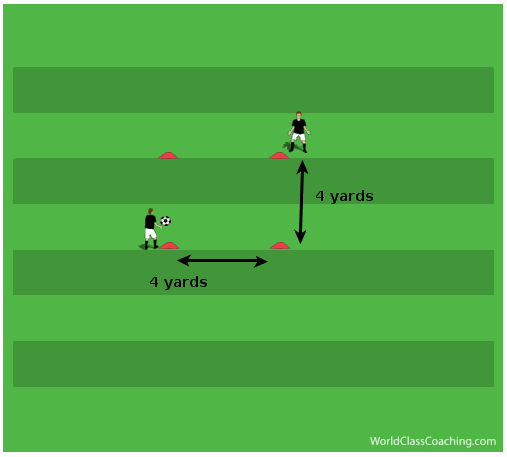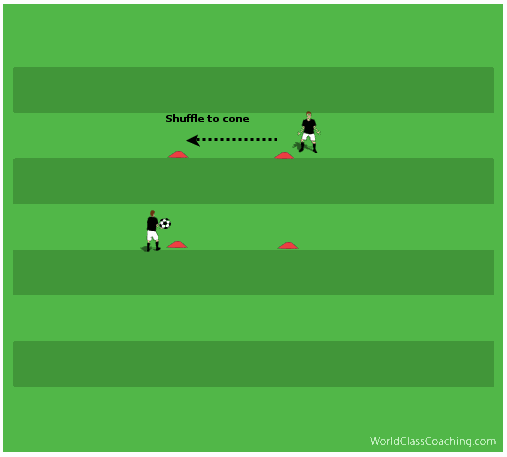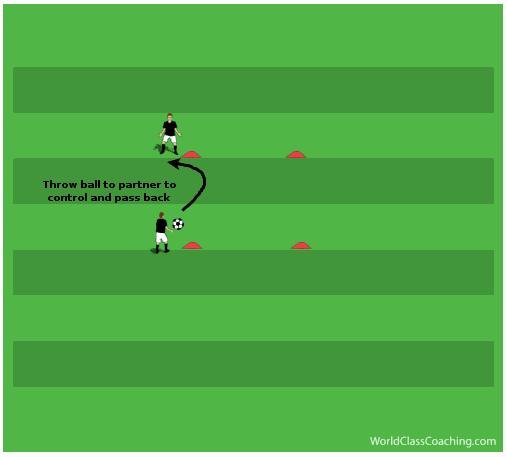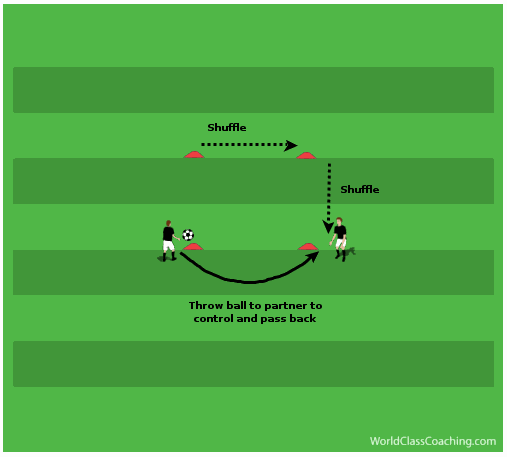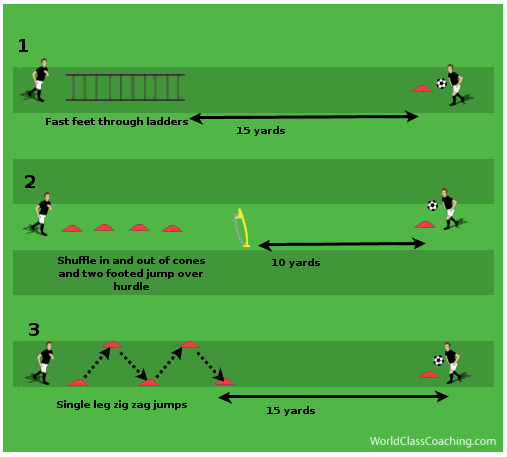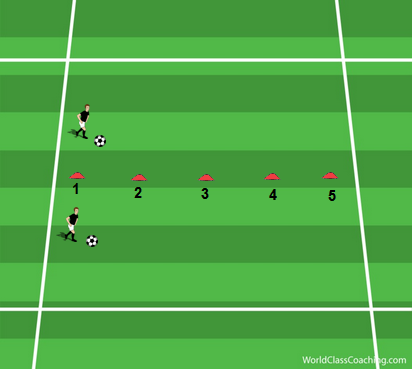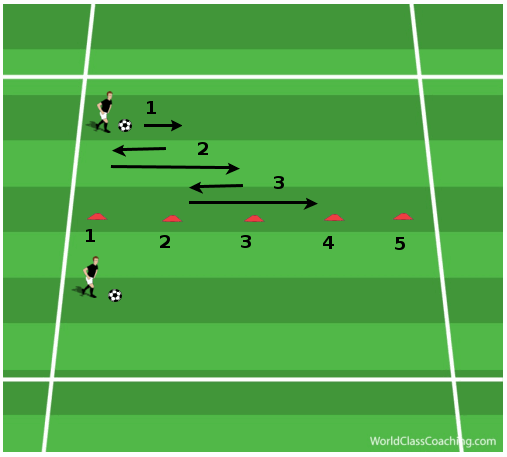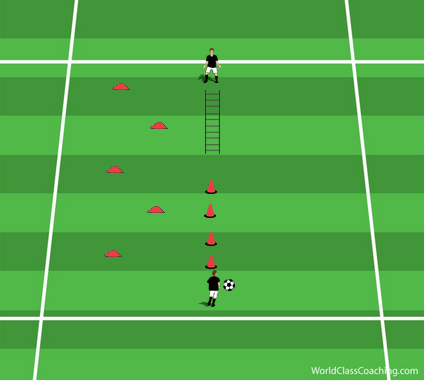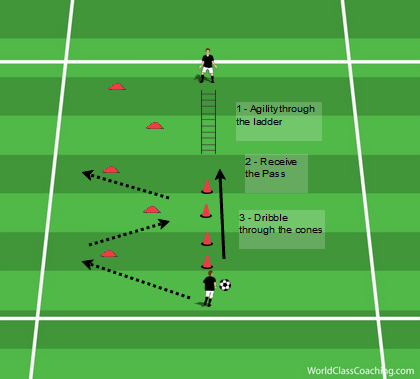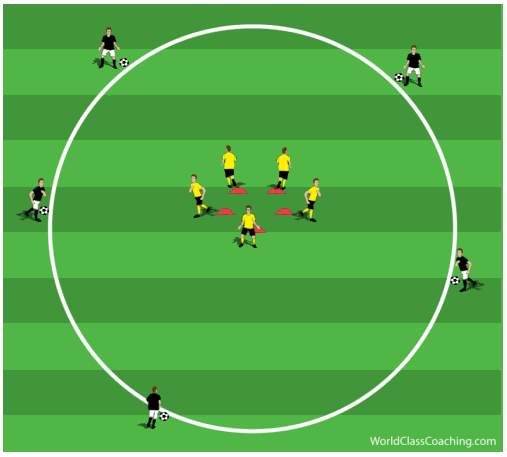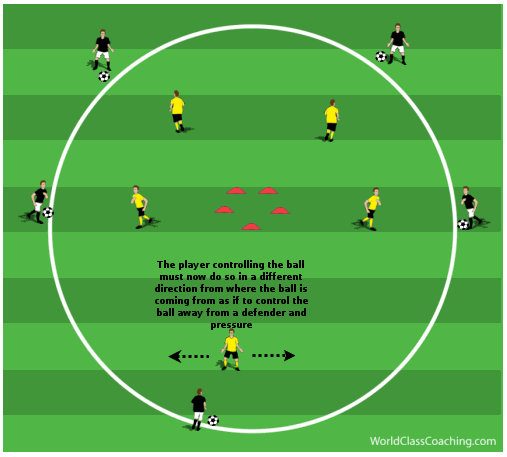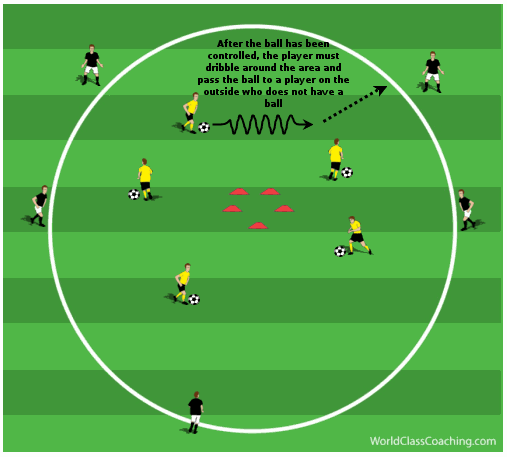Part Two
- First Touch Endurance Box
- Endurance, Agility and First Touch
- Dribbling with Quick Changes of Direction
- Agility, Receiving and Dribbling Circuit
- Working on Anaerobic Endurance, First Touch and How to Lose a Defender
First Touch Endurance Box
By Jebreel Bubtana
This exercise is a great way to work on your player’s first touch at different heights and making sure that technique does not suffer as they get tired.
This exercise starts with a 4x4 yard box and one ball between two players as shown below (figure 1). One player will start with the ball in their hands and the other player will do all of the work for 1 minute.
The player without the ball shuffles to the cone to their right (figure 2).
As soon as the player reaches the cone, their partner throws the ball to them to control with the inside of their foot and pass back (figure 3).
The player will now shuffle past the start cone and across to the next cone to their left as quickly as possible where they will again control the ball with the inside of their foot and pass back to their partner (figure 4). The working player will now shuffle their way past the start cone and back to the cone where they first controlled the ball. The player will continue to work between the two cones for 1 minute. When the 1 minute is up, the players can switch positions.
After they have both had a go at the exercise you can start working on different heights of the ball:
• Inside of the foot volleys
• Laces volleys
• Thigh control and pass back
• Chest control and pass back
• Headers
Once you have worked on all of the heights you can get the thrower to vary the throws to their partner to challenge them. The ball can be thrown to any height and so the partner must react to where the ball is thrown.
It is important that the player throwing the ball is not just throwing the ball lightly to their partner; the aim is that there is a challenge to control the ball and so as a coach, it is important to get your players to understand this.
The aim of the exercise is that it be fast paced with quick switch overs and quick shuffling between the cones. The player shuffling between the cones must work as hard as possible during the 1 minute and it is important that as time goes by, technique is not compromised due to tiredness. You can also increase the amount of time that the player is working between the cones.
Endurance, Agility and First Touch
By Jebreel Bubtana
This exercise works on first touch with different parts of the body as well as agility, coordination and conditioning, which is great way to start your pre-season training.
There are 3 different stations as shown below (figure 1), with players spending 4 minutes working before switching with the feeder and then moving on to the next station.
Station 1:
The player must run through the ladder placing both feet in the gaps of the ladder, after this is done they must sprint to the feeder who will be holding the ball out in front of their body. The player who has just completed the ladders must tap the ball with one hand. As soon as this is done, the feeder will throw the ball high over their partner’s head and they must run back as quickly possible and head the ball back to the feeder before jogging back to the start and going again (figure 2).
Station 2:
The player must shuffle in and out of the cones as quickly as possible before jumping over hurdle with both feet. After this is done they must sprint to the feeder who will be holding the ball out in front of their body. The player who has just completed the agility must tap the ball with one hand. As soon as the ball has been tapped, the feeder will throw the ball high and to either side of their partner. The player must run back as quickly possible, control the ball before it bounces and pass it back to the feeder before jogging back to the start and going again (figure 2).
Station 3:
The player must do single leg jumps to each cone in a zigzag. After this is done they must sprint to the feeder who will be holding the ball out in front of their body. The player who has just completed the agility must tap the ball with one hand. As soon as this is done, the feeder will throw the ball over their partner’s head. The player must run back as quickly possible, control the ball before it bounces and pass it back to the feeder before jogging back to the start and going again (figure 2).
It is important that that the players at each station are working as quickly as possible. The player must react to where the ball is thrown and move their feet quickly to control or head the ball before it bounces, much like in a game situation where a player will try to get to the ball before and opponent and before it bounces. As time goes on fatigue will begin to set in and so it is vital that technique when controlling the ball does not suffer. The pass back is equally as important as the first touch. If the ball is not passed back to the feeder accurately then it is much like a misplaced pass during a game. You can also have the feeder switch with their partner after every go, having them sprint to the start to begin the station. If you decide to do that then I would recommend increasing the amount of time before moving to the next station as the players will be getting a little rest after every go.
Dribbling with Quick Changes of Direction
By Daniel Severn
This week we will focus on quick changes of direction within a fast paced, competitive exercise. I will use the ‘drag-back’ turn as the example throughout the exercise, but any other turn involving a full change of direction can be used (e.g. Cruyff turn, step-over, inside/outside cuts etc).
Set Up and Directions
For this exercise you only need a few cones. The example in the diagram is set up for just two players, but you can add in more ‘lanes’ of cones to involve as many players as you need to accommodate.
Here we have five cones laid out approximately 5 yards apart from each other. Two players begin each with a ball a few yards either side of Cone number 1. On the coaches signal the players accelerate with the ball towards cone 2, perform a drag-back turn and check back to cone 1. The players again perform the drag-back turn and accelerate to cone 3. The players then perform the turn and check back to cone 2. The players repeat this once more, accelerating forward this time to cone 4, performing the turn, checking to cone 3 before turning again and sprinting over the ‘finishing line’ at cone 5.
As you can see there are many turns required in the exercise and it may be a good idea to ‘warm-up’ to the exercise - I’d do one or two practice runs to focus on the technique of the turn itself. After the players are performing the turns consistently, I would pair them as shown above and they would compete against each other to see who can complete the course the fastest.
The direction of movement with turns is shown through to ‘Cone 4’ below:
The conditioning aspect of this game comes when the players are competing versus each other. By adding competition, the players push themselves harder and in turn will develop the turning technique at a more game-realistic speed. They will also be accelerating as fast as possible in between each turn to give themselves the best chance of winning. Again, by putting your players in a situation where they have to push themselves in order to win against their teammates in practice exercises, you will get the best results in time for game day.
I hope you enjoy the exercise!
Agility, Receiving and Dribbling Circuit
By Daniel Severn
This week we focus on agility and technique. Agility plays a huge part in a players’ ability to perform in a game, soccer has so many changes of direction and the more agile players have the best chance of reacting in many different situations – defending, dribbling, intercepting passes to name a few. Technique is also key to a players’ performance, without a good first touch and dribbling skills, a players game can become limited. Developing these aspects of the game can only enhance performance.
This circuit is designed to work groups of 2 or 3 players at a time. I would set up 5 stations exactly the same to allow a full team to work at the same time.
Set Up and Directions
Each station should be set up as shown below. If you do not have a ladder you could use cones to mark out the agility aspect of the mini course.
Player one begins at the start of the ladder and Player two will begin witha ball at the opposite side of the circuit (the end of the dribbling section).
Play begins by player one performing some agility through the ladder. As soon as player one completes the agility, player two plays a pass into player ones’ feet. Player two should ensure that this is a firm pass in order to ensure a good first touch is needed by player one.
At this point both players will work. Player one continues by dribbling through the cones as fast as they can before putting their foot on the ball at the opposite end.
Immediately after playing the pass, player two checks to the left and performs short sharp diagonal sprints between the cones laid out. Player two then finishes in the original start position of player one.
The roles are then reversed and repeated.
Timing
The exercise should be continuous for 2 minutes and the players should be encouraged to work at a high tempo throughout.
Variations
- Agility– quick feet; shuffling; backwards etc.
- Dribbling – the player can use only the inside of their feet to cut through the cones/ sole of the foot only/ outsides only etc.
I hope you enjoy the exercise!
Working on Anaerobic Endurance,
First Touch and How to Lose a Defender
By Jebreel Bubtana
This is a great exercise to use to work on first touch and develop your player's endurance levels. I have used 10 players in this exercise as an example; however the numbers can be modified depending on the size of your squad. The exercise starts with 5 players on the outside of the area with a ball each and the other 5 players in the middle of the area without a ball (figure 1).
The players in the middle run towards the outside players and when they are around 5 yards away, the ball will be passed to them by the player on the outside. They must control the ball and pass it back to the player on the outside (figure 2). The players in the middle have to work for 3 minutes before switching the feeders and players in the middle. 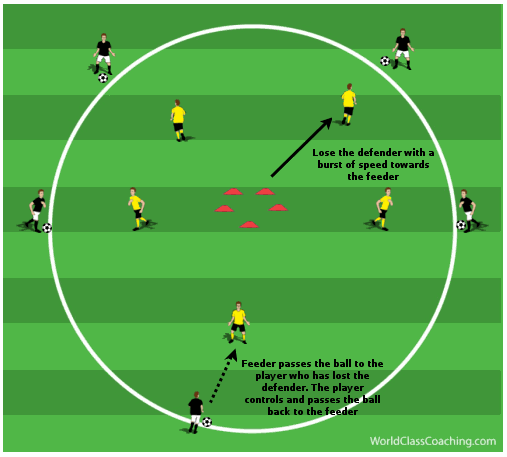
The idea is that the players in the middle must imagine that they are being followed by a defender. In order to get away from this defender they must have an explosive burst of speed towards the feeder on the outside. After they have done this, the player jogs back into the middle before finding another outside player to receive the ball from.
Start the exercise with the feeders passing the ball to the players in the middle before working on controlling the ball with the thigh and chest. You can also get the players in the middle to side foot volley the ball or head the ball back to the feeder.
Coaching Points:
Jog back into the middle after controlling and passing the ball but then explode with speed towards the player on the outside as if to lose a defender in a real game situation.
Relax when controlling the ball.
Make sure that the ball is on the ground before passing to ensure accuracy.
Communication - the player controlling the ball must ask for the ball.
Progression:
The exercise is essentially the same; however, the player controlling the ball must do so to their right or left as if controlling the ball into space (figure 3).
Once the ball is under control they must dribble around the area and pass the ball to a player on the outside who does not have a ball. Verbal and eye communication is essential to ensure that two soccer balls are never passed to a player on the outside at the same time.
Another variation can also be that the feeder must shout either “man on” or “time”. If the player controlling the ball hears the shout of “man on” then they must control the ball and pass it back to the feeder. If the player controlling the ball hears the shout of “time” then they can control the ball into space and dribble around the area before passing the ball to a player on the outside who does not have a ball.
Again with all of these progressions and variations, it is important that as the players get tired that the quality of control of the ball and the pass is not compromised.
Remember, if you liked this article, please help us get the word out and share it on Facebook, Twitter, etc. And don't forget to share your thoughts and ideas by leaving a comment below.

